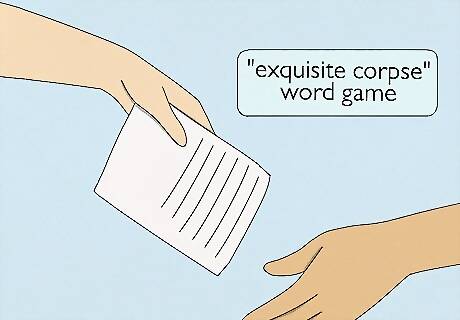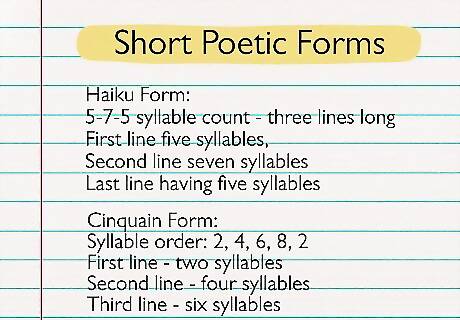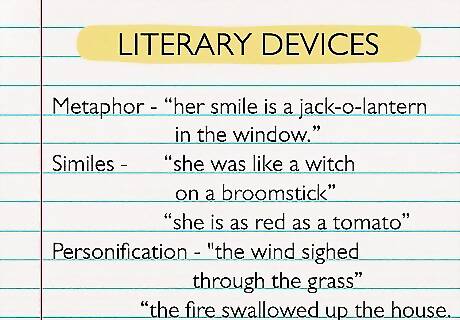
views
Getting Inspiration

Focus on a theme or idea you find taboo. You can find inspiration for your poem by focusing on a theme or idea that you feel may be risky to share with others. Because the poem is for yourself, you can focus on ideas you may think are too taboo or out-of-the-box for a mainstream audience. Creating poetry for yourself gives you the freedom to explore ideas you may not have written about otherwise for fear of judgement by others. You may write about an idea that you consider risky to address, such as abortion, racism, or same-sex marriage. You may feel free to write about this idea from your perspective without the pressure of knowing others are going to read it. Or you may tackle a universal theme in a more unconventional way, such as the theme of love from the perspective of a queer woman or the theme of kindness from the perspective of a serial killer.

Explore an event or moment that you found unsettling. You can also explore a moment that you found unsettling or an event that felt traumatizing in some way. Because you are not showing anyone else the poem, you may feel more comfortable writing about an event that personally affected you negatively or intensely. You may feel okay with addressing the moment in your poem and exploring how and why it unsettled you. For example, perhaps you had an intense near death experience. You may then write about this experience in graphic detail in your poem, revealing feelings and emotions you may have never told anyone about before. Knowing the poem is for your eyes only may make it easier to do this.

Write in an inspirational setting. You may find inspiration for your poetry by putting yourself in a setting you find unique or interesting. You may also choose a setting that you find a little intimidating or scary and push yourself to write ideas down for the poem within the setting. Writing poetry just for yourself means you may want to tackle subject matter that is more taboo or unsettling, and putting yourself in a strange setting can help you get words down on the page. For example, the writer Chuck Palahniuk has been known to write stories in emergency rooms or other strange settings, like airport terminals. You may decide to choose an unconventional setting to write poetry, using the people and events around you as inspiration.

Do a writing prompt. You can get inspiration by using a writing prompt to do a freewrite. You may choose a writing prompt that you find interesting or intriguing. Or you may create your own writing prompt and do a timed freewrite to generate ideas. For example, you may use the writing prompt, “I am writing a poem for myself because…” or “I want to challenge myself to write about…”. You may then set a timer for 10 to 20 minutes and write about the prompt. Try not to lift your pen from the paper or read over what you have written. Once you have finished the freewrite, you should read it over and look for any lines or sentences that feel inspiring or engaging to you.

Read the work of other poets. You can also find inspiration by reading the work of other poets. You may have a favorite poet that you enjoy reading and find inspiring. Or you may choose poets who tend to write about unconventional or taboo subject matter. Some examples may include: The poetry of Claudia Rankine. The poetry of Anne Sexton. The poetry of Adrienne Rich. The poetry of Edgar Allen Poe.
Choosing a Poetic Form

Try the confessional poetry form. Confessional poetry uses the first person “I” to discuss topics that are personal and considered taboo. The form emerged in the mid-twentieth century as a way for poets to address sensitive or private subject matter in their poetry. You can use the confessional poetry form in your poetry to address topics that you may not want to share with others and keep only to yourself. Confessional poets often draw on their own personal experiences and explore them in their poetry. You may try writing about a personal experience that you have kept private or secret and explore it in your poetry. Use the first person “I” to write about your experiences.

Decide if you are going to use rhyme. You should consider if you are going to use rhyme in your poem, and if so, what type of rhyme. You may use end rhymes, where the end of each line rhymes, or you may follow a certain rhyme scheme, such as every other line rhyming or every third line rhyming in your poem. You may opt for using no rhyme scheme at all in your poem, known as the free verse form. Using the free verse form can allow you to be creative in your poem and have the freedom to use whatever words and phrases you'd like.

Choose a surreal poetry form. The surreal poetry form can also be ideal if you are looking for ways to experiment with a topic and address personal subject matter in a unique way. Surrealist poets will often approach a sensitive topic in a creative way. You can apply surrealist techniques to your poetry and play with the form to generate poems. For example, you may choose to do a surrealist word game to get inspiration for your poem. You may try the "exquisite corpse" word game, where you start with a poetry prompt and add to it by passing the paper around the room to different poets. You may also use a surrealist poetry prompt to explore a topic that you find taboo or a personal experience that you would like to write about. You may do a substitution poem, where you replace words in an existing text with your own words or words from another text.

Go for a shorter poetic form. You may decide to try a poetic form that is shorter to allow you to write a poem for yourself quickly or within a limited period of time. You can use a shorter poetic form to frame and organize your poem. For example, you may try a haiku form. Haikus follow the 5-7-5 syllable count and are three lines long, with the first line having five syllables, the second line having seven syllables, and the last line having five syllables. You can also try the cinquain form, which is a five line poem that contains twenty-two syllables total. This poem follows the syllable order: 2, 4, 6, 8, 2. This means first line of the poem contains two syllables, the second contains four syllables, the third contains six syllables, etc. These poems don't necessarily need to rhyme. You may go for a shape poem, where you use the shape of the object or subject you are writing about as the container for the poem.
Creating the Poetry

Use sensory detail. You should always use sensory detail in your poetry to allow your words to jump off the page. Focus on how you can explore the five senses: smell, taste, touch, sight, and sound. You should use details that play on the senses in your poetry so your reader is immersed in your poem. For example, you may describe a moment by focusing on how it smelled or sounded. You may describe a storm as “earthy and smelling of rain” or “pounding the air like a drum.” You may also describe a moment based on how it tasted or felt, such as describing your first kiss as “sweaty and wet” or “sweet, like the ice cream she just licked.”

Tie in literary devices. You should also use literary devices to enhance your poetry and make it more engaging on the page. Literary devices are often used by poets to polish up their language and create imagery that lingers in the reader’s mind. You may use literary devices like metaphor and simile. Metaphors compare one object to another object in an interesting way, for example, “her smile is a jack-o-lantern in the window.” Similes use “like” or “as” to compare one object to another, for example, “she was like a witch on a broomstick” or “she is as red as a tomato.” You can also use literary devices like personification. Personification occurs when an inanimate object, an idea, or an animal is given human attributes, for example, “the wind sighed through the grass” or “the fire swallowed up the house.”

Write with intent and honesty. Because you are writing the poem for yourself you have the freedom to write with intention and honesty. You should strive to be honest and clear in your poems, especially if you plan to show them to only yourself. Be okay with writing about moments or events that may be uncomfortable, unsettling, or disturbing to you. The poetry you write may act as a form of therapy, allowing you to explore feelings you may never otherwise address if you were writing for an audience besides yourself. Focus on how you can infuse the poem with clear details and a sense of confession. You may pretend you are writing the poem to a younger version of yourself or to a person who would never judge you. Picture a forgiving audience and write for them, infusing your writing with honesty and sincerity.

Read the poem out loud to yourself. Once you have finished a draft of a poem, you should read it out loud to yourself. Listen to how the words sound on the page and revise the poem so it flows well. Note any awkward phrases or lines and adjust them. Add in sensory detail if a line sounds too vague or unclear. The poem is meant for your eyes only so you may decide not to revise it completely or polish it like you would if it were meant for publication. You have the freedom to revise the poem as you see fit and adjust it based on how you, the sole reader, respond to the poem.

















Comments
0 comment